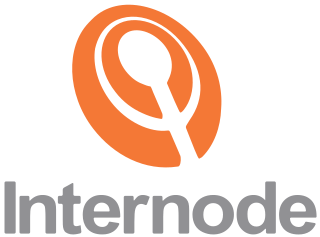Telecommunications in Uruguay includes radio, television, telephones, and the Internet.
Digital subscriber line is a family of technologies that are used to transmit digital data over telephone lines. In telecommunications marketing, the term DSL is widely understood to mean asymmetric digital subscriber line (ADSL), the most commonly installed DSL technology, for Internet access.

Communication in Australia through electronic means using devices such as telephone, television, radio or computer, and services such as the telephony and broadband networks have always been important in Australia given the 'tyranny of distance' with a dispersed population. Governments have driven telecommunication development and have a key role in regulation.

A digital subscriber line access multiplexer is a network device, often located in telephone exchanges, that connects multiple customer digital subscriber line (DSL) interfaces to a high-speed digital communications channel using multiplexing techniques.
A leased line is a private bidirectional or symmetric telecommunications circuit between two or more locations provided according to a commercial contract. It is sometimes also known as a private circuit, and as a data line in the UK.

iiNet Limited is an Australian internet service provider. It was acquired by TPG Telecom in September 2015 for $1.56 billion, but retained its retail brand name in the market. Its subsidiaries include Internode, Westnet, AAPT Limited, Adam Internet, TransACT and Netspace. The company provides ADSL-based Internet access, using their own ADSL2+ infrastructure and reselling Telstra ADSL services, as well as reselling the NBN. iiNet also provides optical-fibre, dial-up, and voice services.

Internode Pty Ltd is an Australian Internet service provider (ISP) that provides ADSL and NBN broadband Internet access, business-class access, web hosting, co-location, Voice over IP, and a variety of related services.

Telkom SA SOC Limited is a South African wireline and wireless telecommunications provider, operating in more than 38 countries across the African continent. Telkom is a semi-privatised, 39% state-owned enterprise.

TM Net is an Internet service provider in Malaysia. As of 2009, it was the only fixed line broadband provider in Malaysia It also provides Internet Protocol television and other multimedia services. TM Net is a wholly owned subsidiary of Malaysia's main telecommunication provider, TM Bhd.
G.992.5 is an ITU-T standard for asymmetric digital subscriber line (ADSL) broadband Internet access. The standard has a maximum theoretical download speed of 24 Mbit/s. Utilizing G.992.5 Annex M upload speeds of 3.3 Mbit/s can be achieved.
TransACT is the trading name of TransACT Capital Communications, an Australian telecommunications company based in Canberra which provides broadband internet access, fixed telephony, cable television services, and mobile phone services in Canberra and a subset of these services in Queanbeyan, throughout South-east New South Wales and in Victoria.

TelstraClear Limited was New Zealand's third-largest telecommunications company before being acquired by Vodafone New Zealand in October 2012.
Whidbey Telecom is a private, independent telecommunications company operating on the South End of Whidbey Island in Washington State, the community of Point Roberts, Washington, and its affiliate Hat Island Telephone Company on Hat (Gedney) Island. Whidbey Telecom is unusual in the region because it is locally owned and has never been a part of a larger company. Whidbey Telecom is also unusual in that 100% of the lines it services are buried underground. The company attributes this action to its mission to provide customer highly reliable telephone and Internet service in an area racked with storms that cause frequent down trees and power outages.
Permanent Internet access was first available in Australia to universities via AARNet in 1989. Pegasus Networks pioneered public use in June 1989. The first commercial dial-up Internet Service Provider (ISP) appeared in capital cities soon after, and by the mid-1990s almost the entire country had a range of choices of dial-up ISPs. Today, Internet access is available through a range of technologies, i.e. hybrid fibre coaxial cable, digital subscriber line (DSL), Integrated Services Digital Network (ISDN) and satellite Internet. The Australian Government, in partnership with the industrial sector, began rolling out a nationwide Fibre to the Premises (FTTP) and improved fixed wireless and satellite access through the National Broadband Network in July 2009. Subsequently, the roll out was down graded to a Multi-Technology Mix on the promise of it being less expensive with earlier completion.
Internet access is widely available in New Zealand. Like Australia, it first became accessible to university students in the country in 1989. As of October 2015, there are 1,926,000 broadband connections and 53,000 dialup connections in New Zealand, of which 1,661,000 are residential and 316,000 are business or government.

Internet in the Czech Republic and Internet access are largely provided by the private sector and is available in a variety of forms, using a variety of technologies, at a wide range of speeds and costs. In 2013, 68% of Czechs were connected to the Internet.
The prevalent means of connecting to the Internet in Germany is DSL, introduced by Deutsche Telekom in 1999. Other technologies such as Cable, FTTH and FTTB (fiber), Satellite, UMTS/HSDPA (mobile) and LTE are available as alternatives.

The United Kingdom has been involved with the Internet since it was created. The telecommunications infrastructure provides Internet access to businesses and home users in various forms, including cable, DSL, and wireless. The Internet country code top-level domain (ccTLD) for the United Kingdom is .uk and is sponsored by Nominet.
Broadband Internet in Israel has been available since the late 1990s in theory, but it only became practical to most customers in 2001. By 2008, Israel has become one of the few countries with developed broadband capabilities across two types of infrastructure—cable and DSL—reaching over 95% of the population. Actual broadband market penetration stands at 77%, ranked 7th in the world. in 2010, Israel was ranked 26th in The Economist's Digital Economy Rankings.











